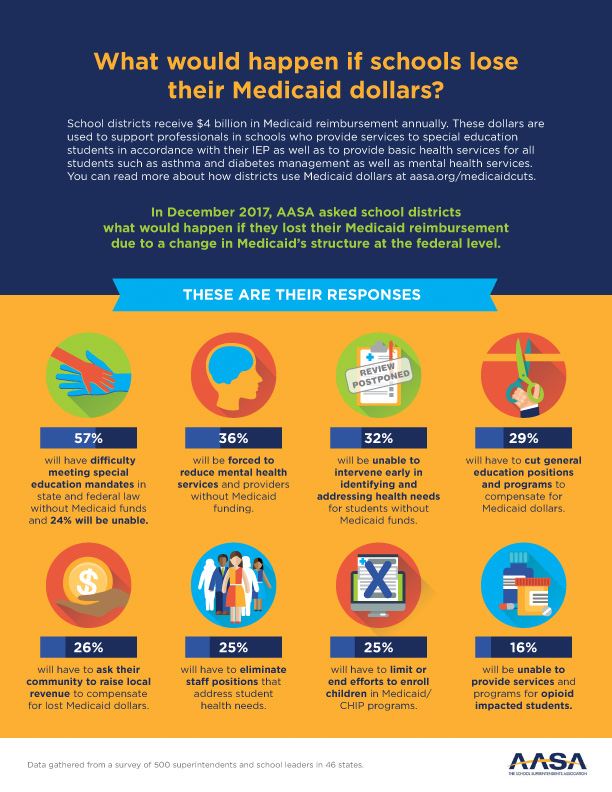Highlights from the AASA Annual Report on the Impact of Medicaid Cuts on Schools
March 7, 2018
Since 1988 Federal law has allowed schools to bill Medicaid for medically necessary services provided to children with an individualized education plan (IEP) under the Individuals with Disabilities Education Act (IDEA). Despite the complexities involved with billing Medicaid for these services, the benefits are rewarding for both students and districts.
In the past year, Republicans proposed reducing federal Medicaid spending by about 25-30%, which would have dire consequences for school districts and students. In response, the School Superintendents Association (AASA) surveyed about 1,000 school leaders from 42 states on the possible consequences of these cuts and the findings in their 2017 report – Cutting Medicaid: A Prescription to Hurt the Neediest Kids report – are telling:
(1) Many respondents answered that students in special education programs would be negatively impacted and there would be increased concern on the district to meet federal mandates on special education programs.
(2) In response to how districts use their Medicaid reimbursement, two-thirds of the respondents said they use Medicaid funds to directly pay for salaries of health care professionals, nearly half said they used the funds to expand health-related services, and a quarter is used on other expenses like equipment and technology for students with disabilities, transporting students with disabilities, and professional development for special education professionals and personnel.
(3) The cut to Medicaid funding could also produce new local taxes to subsidize special education programs for low-income students. That is, if the Medicaid funding stream is reduced, the source of funding would have to come from a different source, such as in the form of taxes.
One of the main concerns in the 2017 report is the impact of implementing a per-capita cap or Medicaid block grant to re-distribute Medicaid funding costs from the federal to state level. A block-grant would mean that school districts would lose the dedicated source of funding currently used to reimburse services provided to students with disabilities, and instead, would have to compete with institutions like hospitals to obtain reimbursement. Compounded by the fact that current levels of Medicaid funding are insufficient to cover the costs of providing services, a change to a per-capita cap or block-grant would be detrimental for all students, adult providers, and the community at large. With a Medicaid block-grant in place, districts would still be required to prioritize mandated special education services, which means they would be forced to cut services where they are legally allowed, such as funding for general education programs. Furthermore, a potential cut to Medicaid reimbursement could also impact budgets for special education staff and related service personnel as their salaries are directly dependent on Medicaid.
The 2017 report was critical to the AASA in successfully advocating against these cuts as legislation made its way through the House and Senate.
As a follow up to the initial report, the AASA more recently surveyed more than 500 school leaders in 46 states and asked, “What would happen if school districts lost all of their Medicaid funding?”
Top findings from the 2018 addendum are pictured below:
Studies have shown that healthy children perform better in terms of academic achievement, attitudes, and behavior. Accelify’s mission is built around ensuring students receive all the health and related services necessary to succeed in school and beyond, and that schools can maximize Medicaid funding available for providing these services. As cuts to Medicaid continue to threaten such services and their funding, we stand with the AASA in their call to Congress “to weigh how children will be impacted by a Medicaid block grant and to reach out to school leaders for specific insights about the importance of their school-based Medicaid programs for students.”
